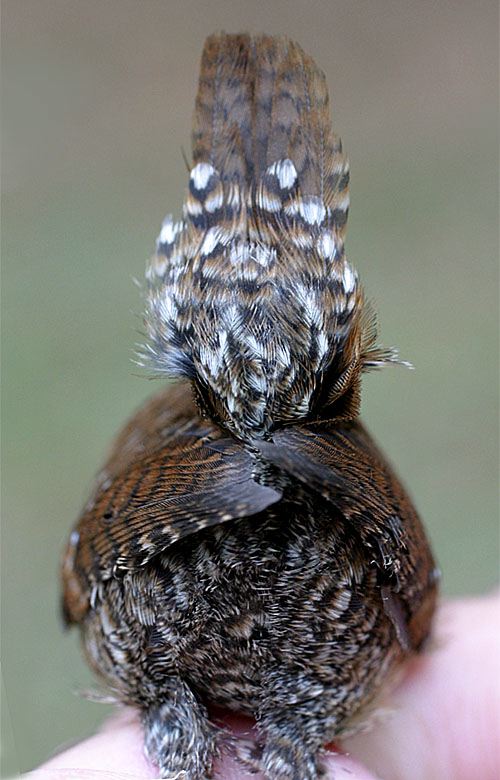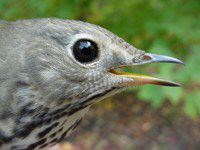|
|
|||
|
|
|||
|
DIFFERENT VIEWS OF THE Little did we suspect last week--after we ran a small photo of the seventh-ever Winter Wren banded at Hilton Pond Center--that we would capture our eighth this week and be prompted to write a longer essay about this tiniest of North American wrens. Herein we also provide a different view--in more ways than one--of this uncommon cold-weather visitor to the Carolina Piedmont. 
All text & photos © Hilton Pond Center Despite the thrice-life-sized photograph above of a Winter Wren's posterior, these birds are indeed quite small, barely tipping the scales at about nine grams. (An actual-size rendering is below left.) If it weren't for our two species of kinglets (6-8g), Winter Wrens would be the smallest songbirds in the Carolina Piedmont. (By comparison, female Ruby-throated Hummingbirds weigh in at 3.5g or so and balloon to 6.5g when they lay on the fat for fall migration.) The wings and tail of the Winter Wren are also disproportionally short, the latter usually measuring about 30mm long; this length seems even shorter when the Winter Wren holds its rear appendage perfectly erect (below right). In this position the little bird sometimes chips loudly at an intruder and gives real meaning to the word "perky." Winter Wrens share a prominent characteristic with their wren relatives: fine, dark barring on wings and tail. In fact, the Winter Wren is among the most heavily barred wren species, with even the undertail coverts and leg feathers showing well-defined black crossbars (see top photo). Winters Wrens in the eastern U.S. typically have white bars contrasting with black, while western populations are much darker and lack the white. Of 59 wren species, only the Winter Wren occurs outside the New World, and it is found in Europe, Taiwan, Japan, and northern Africa. Some biogeographers suspect the Winter Wren crossed into Asia, perhaps as long as two million years ago when the Bering Sea land bridge connected the Eastern and Western Hemispheres. Winter Wrens are sometimes called "mouse-like" because they are little and dark brown and stay close to the ground, foraging about like a rodent. Whether on their nesting or wintering grounds, they bob their heads almost continuously and tend to hang out near water, often inhabiting dense, dark thickets. When we catch Winter Wrens at Hilton Pond Center, they typically get snared in mist nets along the pond edge or at a small garden pool outside our office window. We also see them--but only occasionally--as they creep and flit from one brush pile to the next, undoubtedly in search of insects and other invertebrates that almost exclusively comprise their diet. Although the Winter Wren is small, it has a big voice. In fact, it has been said that per gram of body weight, the male Winter Wren produces more song than any bird in North America. The male's voice is surprisingly loud, and on the breeding grounds he sings for seven or eight seconds at a stretch, with more than a hundred separate notes rising and falling in rapid succession. Younger males sing fewer and simpler songs, but experienced males can have a song book with nearly three dozen different scores. Among Winter Wrens, however, it is not sufficient for the male to be a good songster; he must have consummate building skills. The male constructs up to four partial "dummy nests" of sticks and moss, and then the female--whose attention was initially won by vocalizations-- inspects the nests. Upon finding one to her satisfaction, she helps complete it with a lining of feathers and/or animal hair. Unfinished nests could also serve as decoys that distract potential predators--including other Winter Wrens that may pip the eggs of their rivals. We should mention that a Winter Wren nest is typically in an old stump, woodpecker cavity, or rock crevice, with a roof over the cup. It is this covered structure that gives rise to the wren family name "Troglodytidae," which means "cave dweller." After mating, the female Winter Wren lays 4-7 white eggs with brownish-red spots; it is not known whether the similar-looking parents share incubation duties. Eggs hatch in about two weeks and chicks fledge about three weeks later, after which the parents feed and monitor them away from the nest for up to 40 days. This rather lengthy period of parental care significantly enhances an offspring's chances for survival. It also lessens the possibility for double-brooding--especially for pairs that breed at the northern edge of the Winter Wren's range where the "growing season" is shorter.
Although taxonomists agree the Winter Wren should be grouped in the Troglodytidae with the rest of the wrens, there is controversy over its genus. Historically, the Winter Wren's scientific epithet was Troglodytes troglodytes, indicating a close relationship to the less vocal House Wren, T. aedon. Based on DNA studies and the Winter Wren's complex song, a few taxonomists propose that it be in its own genus, Nannus, but the American Ornithologists' Union--final arbiter on taxonomy for our native bird species--is sticking with Troglodytes troglodytes, at least for now. We leave it to you to decide which different taxonomic view and which different photographic view of the Winter Wren at Hilton Pond Center you like the best. "This Week at Hilton Pond" is written and photographed by Bill Hilton Jr., executive director of Hilton Pond Center for Piedmont Natural History. just send us an e-mail with "Subscribe" in the subject line. |
| Make direct donations on-line through Network for Good: |
|
|
| Donate a portion of your purchase price from 500 top on-line stores via iGive: |
|
|
| Use your PayPal account to make direct donations: |
|
|
|
|
SPECIES BANDED THIS WEEK: * = New species for 2003 WEEKLY BANDING TOTAL 9 species 15 individuals
YEARLY BANDING TOTAL (2003) 61 species 996 individuals
BANDING GRAND TOTAL (since 28 June 1982) 123 species 43,110 individuals
NOTABLE RECAPTURES THIS WEEK (with original banding date, sex, and current age) Northern Cardinal (1) 07/29/02--2nd year male |
OTHER SIGHTINGS OF INTEREST  Although this species resembles a Swainson's Thrush at first glance, the Hermit Thrush's rusty tail is a sure identification mark. This is the only spot-breasted thrush found regularly in wnter in the Carolina Piedmont.
VAGRANT HUMMINGBIRDS --THREE female Rufous Hummingbirds were banded in Ashe County NC on 7 Nov. |
|
|
|
Up to Top of Page Current Weather Conditions at Hilton Pond Center |
 You can also You can alsopost questions for The Piedmont Naturalist |
Join the |
Search Engine for |
|
|